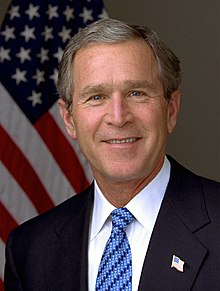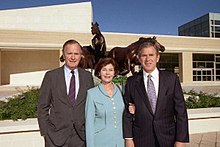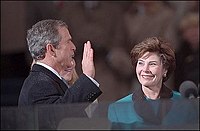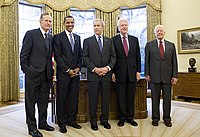Type a search term to find related articles by LIMS subject matter experts gathered from the most trusted and dynamic collaboration tools in the laboratory informatics industry.
George W. Bush | |
|---|---|
 Official portrait, 2003 | |
| 43rd President of the United States | |
| In office January 20, 2001 – January 20, 2009 | |
| Vice President | Dick Cheney |
| Preceded by | Bill Clinton |
| Succeeded by | Barack Obama |
| 46th Governor of Texas | |
| In office January 17, 1995 – December 21, 2000 | |
| Lieutenant | Bob Bullock Rick Perry |
| Preceded by | Ann Richards |
| Succeeded by | Rick Perry |
| Personal details | |
| Born | George Walker Bush July 6, 1946 New Haven, Connecticut, U.S. |
| Political party | Republican |
| Height | 1.81 m (5 ft 11 in) |
| Spouse(s) | |
| Children | Barbara Jenna |
| Parents | George H. W. Bush (father) Barbara Pierce (mother) |
| Relatives | See Bush family |
| Education | Yale University (BA) Harvard University (MBA) |
| Religion | Methodism |
| Signature |  |
| Website | Official website Presidential Library Presidential Center White House Archives |
| Military service | |
| Nickname(s) | |
| Allegiance | |
| Branch/service | • Texas Air National Guard • Alabama Air National Guard |
| Years of service | 1968–1974 |
| Rank | |
| Unit | |
| Awards | |
George Walker Bush (born July 6, 1946) is an American politician and businessman. He was the 43rd president of the United States from 2001 to 2009. He is the son of former U.S. President George H. W. Bush and former U.S. First Lady Barbara Bush. Before becoming president, he was the Governor of Texas from 1995 to 2000. Bush is a member of the Republican Party.[4]
He flew warplanes in the Texas and Alabama Air National Guard. After graduating from Yale College in 1968 and Harvard Business School in 1975, he worked in the oil industry. In 1977, he married Laura Welch and ran for the U.S. House of Representatives, but lost. He later co-owned the Texas Rangers baseball team.
In 1994, he was elected Governor of Texas, defeating the incumbent governor, Democrat Ann Richards. As governor, Bush successfully backed legislation for tort reform, gave more money for education, set higher standards for schools, and changed the criminal justice system. Bush also helped make Texas the leading producer of wind powered electricity in the U.S.
In 2000, Bush was elected President of the United States when he defeated Democratic incumbent Vice President Al Gore in an extremely close election. He became the fourth person to be elected president without winning the popular vote. He is the second son of a former United States president to himself become president, the first being John Quincy Adams, the son of John Adams.
Bush was inaugurated in January 2001. As president, his earlier focus was on domestic issues. He cut taxes, passed an education reform bill, made changes to Medicare, and changed abortion laws. On September 11, 2001, the United States was attacked by Al-Qaeda, a terrorist organization, via the World Trade Center and the Pentagon. As a result of these attacks, Bush created the Department of Homeland Security and started a "War on Terror" that began with a war in Afghanistan in 2001. He also signed into law the Patriot Act in order to inspect on people believed to be terrorists. In 2003, he ordered an invasion of Iraq, which started the Iraq War. The reason why he did this was because his administration claimed that Iraq had a weapons of mass destruction (WMD) program, and that the Iraqi government was a threat to the U.S. However, no WMDs or a program for WMDs were ever found.
He was re-elected to a second term in 2004, against Democrat John Kerry. In his second term, Bush reached multiple free trade agreements and was able to put John Roberts and Samuel Alito to the Supreme Court. He wanted to make major changes to Social Security and immigration laws, but these changes did not pass in Congress. The wars in Afghanistan and Iraq continued, and in 2007 he sent more troops to Iraq. Bush received criticism from both sides politically for his handling of Hurricane Katrina and for the midterm dismissal of U.S. attorneys. Around December 2007, the U.S. entered the Great Recession. This made the Bush administration create programs for protection of the country's financial system, such as the Troubled Asset Relief Program (TARP).
Bush left office in January 2009, succeeded by Democrat Barack Obama, after an election against Republican John McCain. He has a ranch in Crawford, Texas, which is near Waco.[5] In 2010, he published a memoir called Decision Points. His presidential library opened in 2013. Though ranked a bit low in rankings of presidents by scholars and historians, public opinion on Bush has improved after his presidency ended. Bush received the highest recorded approval ratings right after the 9/11 attacks, but one of the lowest such ratings during the 2008 financial crisis.

Bush was born at Yale-New Haven Hospital in New Haven, Connecticut.[6][7] Bush grew up in Midland, Texas. He went to a high school called Phillips Academy in Andover, Massachusetts, and graduated in 1964.[8][9] He went to school at Yale University from 1964 until he graduated in 1968,[10][11] with a bachelor's degree in history.[12] He joined the Texas Air National Guard in 1968[13][14] (part of the United States National Guard) during the Vietnam War and became a fighter pilot but did not fight in the war. He left the Texas Air National Guard in 1973.[15] In 1975 Bush earned an MBA from Harvard University.[12]
On November 5, 1977, Bush married Laura Welch.[16] In 1978, Bush tried to get elected to Congress in West Texas, but lost. After that, he ran some oil companies and was one of the owners of the Texas Rangers baseball team. He thought about trying to become the commissioner of Major League Baseball, but went into politics instead.[17] Bush is a Methodist.[18] In 1994, he was elected to be Governor of Texas,[19] defeating incumbent Democratic Governor Ann Richards.[12]

Bush announced he was running for governor in the 1994 Texas gubernatorial election. His campaign focused on four themes: changing welfare, changing torts, crime reduction, and making education better.[20]
He easily won the Republican primary. His opponent was popular Democratic incumbent Governor Ann Richards.[20][21] During the campaign, he said that if he was elected, he would sign a bill that would allow Texans to get permits to carry concealed weapons (this means a person can carry a weapon on them, as long as it cannot be seen).[22] Bush won the general election with 53.5 percent against Richards' 45.9 percent.[23]
Bush used a budget surplus (when the government makes more money than it spends) to pass a $2 billion tax-cut, which was Texas's largest.[24] He used government money to fund organizations that teach people of the dangers of alcohol and drug use and abuse, and helping to reduce domestic violence.[25]
In 1998, Bush won re-election with a record 69[20] percent of the vote.[26] He became the first governor in Texas history to be elected to two consecutive four-year terms.[20] In his second term, Bush promoted faith-based organizations and had high approval ratings.[20] He proclaimed June 10, 2000, to be Jesus Day in Texas, a day on which he asked all Texans to "answer the call to serve those in need".[27] In 1999, Bush signed a law that said electric retailers needed to buy a certain amount of energy from renewable sources.[28][29][30] This helped Texas become the leading producer of wind powered electricity in the U.S.[31][32][33]
Critics said that during his time as governor, Texas ranked near the bottom in environmental evaluations. Supporters pointed to his efforts to raise the pay of teachers and improve educational test scores.[20]
During Bush's first term, he was seen as a future presidential candidate. After he was reelected in 1998, this belief grew. In 1999, he decided to seek the 2000 Republican presidential nomination.
Bush ran against then-Vice President Al Gore in the 2000 United States presidential election.[34] More than 100 million people voted on November 7, 2000.[35] But the election was very close. When they began counting the votes, it became clear that whoever got the most votes in the state of Florida would win the election. But there were many issues with the ballots in Florida. Gore sued to get Florida to count the votes again. For more than a month no one knew who won the election. The Supreme Court made a decision to stop recounting votes.[36] Gore decided to accept his loss on December 13 and Bush was declared the winner.[37]

While he was president, George W. Bush signed the No Child Left Behind Act into law.[38] It was an education reform bill.
Bush was the second President of the United States to deliver a speech in both Spanish and in English.[39]
He added Part D to Medicare,[40] which gives older people free medicine if they can not afford it.
He also signed very large tax cuts (many of them were for the middle and lower class) during his presidency.
Bush did not approve of abortion.[41] In 2004, he signed the Unborn Victims Of Violence Act[42] which made it so that if a pregnant woman is murdered, her murderer can also be charged with killing the fetus that the woman was carrying.[43]
His first foreign policy test came when an American spy plane crashed in China. Bush peacefully negotiated the release of the plane crew.[44]

Eight months after Bush became president, the September 11 attacks occurred. Because of this, President Bush declared a War on Terrorism.[45]

Bush tried to do many things to stop another terrorist attack from happening. He ordered an invasion of Afghanistan in 2002.[46] He did this because the leaders of Afghanistan were helping Osama bin Laden, who was responsible for attacking America on September 11, 2001. Almost ten years later, on May 2, 2011 bin Laden was killed on orders of President Barack Obama. Bush asked Congress to do more to stop terrorism. As a result, Congress passed a law that created the Department Of Homeland Security, a government department which tries to prevent terrorist attacks from happening. It also responds to emergencies such as floods or diseases.
He signed the Patriot Act (which allowed the government to listen to people's phone calls so it can track down terrorists which try to communicate with each other).[47]
After Saddam refused to cooperate with the United Nations weapons inspectors[48] and the United States Congress authorized Bush to invade Iraq if its government did not cooperate with the weapons inspectors,[49] Bush decided on the Gulf War in 2003[50] with several allies.[51] Saddam Hussein was removed from power, and Iraq turned into a democracy. Over 100,000 people were killed in this war.
In the 2004 presidential election, Bush won again with a majority of votes. His opponent was Massachusetts Senator John Kerry, a Democrat.[52]

In 2005, Hurricane Katrina (the most destructive hurricane in American history) happened.[53] It caused over 1800 deaths and caused billions of dollars of destruction. George W. Bush signed several acts into law which would help Hurricane Katrina victims.

In the Iraq War, no weapons of mass destruction were found, and the Bush Administration was criticized for being wrong about Iraq having weapons of mass destruction. Bush added more American troops to Iraq (which was called "the surge") to speed up the war. The surge was successful, and in result, Iraq had less violence.
Although the economy was doing very well during much of his presidency, in early 2008, the economy was slowing down. Bush signed a bill into law which would gave $600 to every American citizen, hoping that people would go out and spend the money so that it would prevent a recession (a bad economy) from happening.
Later in 2008 December, stock market crashed and the country fell into its worst recession since the Great Depression. Bush helped create a 700 billion dollar bailout, which would give money to corporations (large businesses) to prevent them from being bankrupt and to try to prevent the recession from getting worse.
Bush publicly supported Republican candidate John McCain during the 2008 presidential election,[54] but Barack Obama won the election.[55] During the last few days he was president, Bush gave his farewell address. He was succeeded by Barack Obama on January 20, 2009.

After his presidency, Bush stayed away from the spotlight and did not want much attention. He said that he was not going to criticize President Barack Obama.[54] He began to build his presidential library in 2010.[56] It was open to the public in 2013.

After over a year and a half of saying little in public, in November 2010, Bush appeared on several television interviews and released a book called Decision Points. The book focuses on fourteen big decisions he made in congress, including quitting drinking, running for president, Hurricane Katrina, invading Iraq, and his response to the financial meltdown in 2008.
On May 2, 2011, President Obama called Bush, who was at a restaurant with his wife, to inform him that Osama bin Laden had been killed.[57] The Bushes joined the Obamas in New York City to mark the tenth anniversary of the September 11, 2001, terrorist attacks. At the Ground Zero memorial, Bush read a letter that President Abraham Lincoln wrote to a widow who lost five sons during the Civil War.[58]
On August 6, 2013, Bush was successfully treated for a coronary artery blockage with a stent. The blockage had been found during an annual medical examination.[59]
{{cite encyclopedia}}: |work= ignored (help)
![]() Media related to George W. Bush at Wikimedia Commons
Media related to George W. Bush at Wikimedia Commons